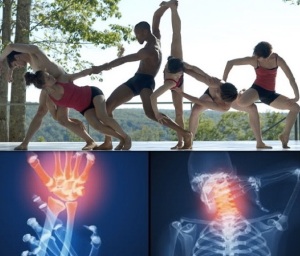ITB Syndrome? Stretch those glutes and hip flexors!

Ilio-Tibial Band Syndrome affects the outside of the thigh – usually around the hip or closer to the knee, where this large tendon-like structure can rub against the outside of the heads of the femur. Under normal circumstances, this movement over the bones happens without consequence, but through over-training, weakness in muscles (particularly the glutes) or bad alignment, excess friction can lead to inflammation and pain. Treatment should proceed with rest and ice for 3-5 days. It is widely accepted that foam rolling or ‘manual stripping’ (by a therapist) of the ITB helps to improve blood supply and flexibility to the area, thus improving symptoms. Roll from the bottom – up (knee to hip). However, because the ITB is meant to stabilise the knee and hip, it’s not designed to stretch! In my opinion, increasing flexibility in the muscles that attach to it (glutes and hip flexors) is far more beneficial. Dancers often find the usual stretches don’t target the area sufficiently. I use the stretches in the photo (starting with a raised back, then leaning forward to rest the chest on the leg and eventually adding the twist and holding the toe). Make sure you check your technique and don’t over-train!
Noisy Joints?
“Why do my joints crack and why does it feel so good” is a question that I’m asked quite often, so here is the answer:
Your joints crack for 3 main reasons:
1 – Gas dispersing in the joint capsule
2 – Tendons or ligaments moving over other soft tissues/bone
3 – Crepitus due to wear and tear of cartilage
The first is usually the most common reason. Synovial (the most mobile) joints, are encased in thick synovial fluid within the joint capsule. When the bones in the joint are taken to their maximum range under pressure (e.g. lacing the fingers and pushing the palms away from you), the whole unit is stretched, which increases its volume, thereby decreasing the pressure inside the joint. This allows gases within the fluid to disperse. This process is called ‘Cavitation’ and explains the audible ‘pop’ that you hear when joints are manipulated. It usually takes 30 minutes to a few hours for the gas to build up, which is why you often have to wait a while before you can crack the joint again. If a joint does pop or crack repeatedly, it may be a sign that the sound is coming from a tendon or ligament.
The reason people often feel a release after cracking a joint is that the ‘Golgi Tendon Organ’ (which senses and monitors the amount of tension in soft tissues) is stimulated and sends a signal to relax the surrounding muscles.
The good news is that there isn’t any hard evidence that repeatedly cracking joints, be it a back, ankle, knee, knuckle, hip or neck, will cause arthritis. However, it can certainly lead to overstretched ligaments, which may cause weakness and potential pain.
Flexibility vs Stability
Is flexibility AND stability a reality? In order to have good stability, you generally have to sacrifice flexibility and vice versa. This is a conundrum that many dancers face. We all want to be able to kick our head in a battement or brush the ground with our hair in a back bend, but at what cost? Dancers who have this kind of wonderful pliability, often suffer from certain kinds of injuries due to the nature of their soft tissues. Supple muscles, tendons and ligaments mean dancers are more prone to dislocations and serious sprains. On the other hand, dancers who battle with limited flexibility can sustain injuries such as hamstring strains and tendinosis (degeneration of the tendon that attaches the muscle to the bone). Of course neither group’s injuries are exclusive, but it is a reality that all dancers must face; flexibility AND stability are a rare and greatly sought after combination.
Naturally flexible dancers should work on their strength and proprioception (the position of their body and its parts in space). Less flexible dancers should stretch continually, but at a comfortable level. Always remember that you’re working with your nervous system and have to allow it to accept the desired length of muscle fibres. If it hurts, your body will think it’s in danger and contract the tissues further!
Images from ‘Dance first, think later’ on Tumblr
Image of female dancer: Ronnie Boehm Dance Photography


Recent Comments